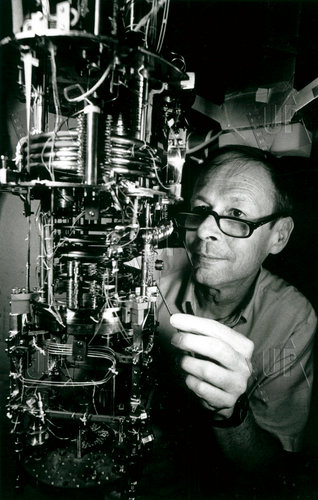
Robert C. Richardson, who shared the 1996 Nobel Prize in Physics for coaxing a rare form of helium into a bizarre liquid state that had never been seen before, died on Tuesday in Ithaca, N.Y. He was 75.
The cause was complications of a heart attack he suffered three weeks earlier, according to Cornell University, where Dr. Richardson had been a physics professor since 1968.
In 1971, Dr. Richardson and two colleagues David M. Lee, also a physics professor, and Douglas D. Osheroff, a graduate student collaborated on a technically challenging experiment, exploring the properties of atoms a fraction of a degree above absolute zero.
They cooled helium-3, a lighter variant of helium, to within a few thousandths of a degree of absolute zero. Absolute zero is the lowest possible temperature, at which motion comes to almost a complete stop.
In that deep freeze, liquid helium-3 turns into what physicists call a superfluid a liquid that flows without friction.
I quickly tell people it has no practical applications, Dr. Osheroff said in an interview on Wednesday. But the discovery has enabled scientists to study a variety of scientific problems, including basic quantum interactions at the atomic level. The Nobel Prize committee deemed the experiment a breakthrough in basic physics.
Decades earlier, scientists had discovered that helium-4, the common form of helium that fills balloons and airships, becomes a superfluid at minus 456 degrees Fahrenheit, or about 3.5 degrees above absolute zero. But because helium-4 has one additional neutron, it exhibits very different properties as a superfluid from what the Cornell physicists discovered.
In fact, the helium-3 data turned out to be so different from what theorists had predicted that the three researchers initially misinterpreted what they had created.
The experiment was also one of the first uses of nuclear magnetic resonance to generate images out of radio waves emitted by the atoms. That is the same principle that underlies the M.R.I. machines that doctors today use to peer inside patients bodies.
Dr. Richardson was later a member of the National Science Board, the policy-making body of the National Science Foundation. He was one of the authors of a National Academy of Sciences report in 2005 that urgently called for better science education and other measures to keep the United States competitive in a global economy.
Robert Coleman Richardson was born on June 26, 1937, in Washington, the first child of Robert F. and Lois Price Richardson. (A sister, Addie, was born two years later.) The family lived in Arlington, Va. His father, the son of a rural general store owner who traced his family to early Colonial times, worked for a telephone company; his mother grew up an orphan in North Carolina and earned a masters degree in history.
Robert attended Washington-Lee High School in Arlington. There was nothing exceptional about the math and science training at Washington-Lee, he wrote in his autobiography for the Nobel Prize. The idea of advanced placement had not yet been invented. I did not take a calculus course until my second year of college. The biology and physics courses were very old-fashioned.
He went on to earn a bachelors degree in physics at Virginia Polytechnic Institute.
I was not an especially diligent student but nevertheless obtained a reasonable education in physics, he wrote. I graduated with a B average and fourth in a group of about nine physics majors.
At the time he thought he would go to business school, with the aim of becoming a corporate executive. But he remained at Virginia Tech for one more year to obtain a masters degree in physics. Afterward he served in the Army for half a year rather than the usual two-year enlistment. He called his abbreviated service a great piece of good fortune when the Army ran short of money.
In the Army he received training in managing a platoon that repaired jeeps and tanks. The experience, he said, soured him on becoming an executive. He decided to return to physics and graduate school, this time at Duke.
There he began working with helium-3, which was then still a rare substance, a byproduct of the atomic age. The common form, helium-4, has a nucleus of two protons and two neutrons. Helium-3, with two protons and only one neutron, is extremely rare in nature. But it forms in the decay of tritium, a key ingredient of the hydrogen bomb.
With the advent of nuclear arsenals in the 1950s, helium-3 became available for physicists to experiment with. For his doctoral research, Dr. Richardson studied solid helium-3 using nuclear magnetic resonance techniques.
He was very quick in understanding what was going on, said Horst Meyer, his thesis adviser at Duke. He was a very persistent and hard worker. All qualities that very much endeared him to me.
Dr. Richardson moved to Cornell in 1966 as a postdoctoral researcher and was promoted to assistant professor two years later.
He served as Cornells first vice provost for research from 1998 to 2003 and was a member of the board at Duke from 1997 to 2007. He was also a member of the National Academy of Sciences.
Dr. Richardson is survived by his wife, Betty; his daughter, Jennifer Merlis; and four grandchildren.
Create Date :22 กุมภาพันธ์ 2556
Last Update :22 กุมภาพันธ์ 2556 15:46:03 น.
Counter : 3275 Pageviews.
Comments :0
- Comment
